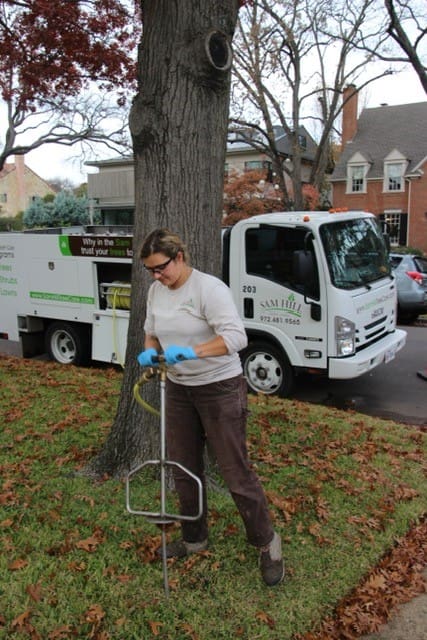
When you think about fertilization, the first thing that comes to mind is probably your clients’ lawns, but it’s important not to forget that other plants in the landscape can benefit from regular fertilization as well, like trees and shrubs.
Do Trees Really Need Fertilizer?
Trees’ needs can often be overlooked by clients unless it is visually declining. While some clients understand the value of tree fertilization, others may need to be educated on the benefits it can provide.
“When trees are planted, a lot of times you forget that they need food as well and nutrients,” says James Brewer, a sales arborist with The Davey Tree Expert Company, based in Kent, Ohio. “Oftentimes available nutrients usually aren’t there like in the soils on a newer build or even on older homes as nutrients dissipate throughout the soil and you oftentimes need to reestablish it in the soil by putting more fertilizer in there.”
Chris O’Bryan, co-owner of Limbwalker, based in Louisville, Kentucky, says they often tell clients to think of fertilizer as vitamins and without them, it can be the limiting factor for a tree’s growth. Aside from promoting tree growth, fertilization can provide needed nutrients to a tree that’s declining and extend the life of the tree.
“I have found it’s important to find out how valued the tree is to them, and then go into the benefits and reasons why we should be fertilizing,” Ken Wickham, an account manager with Joshua Tree Experts, based in Stockertown, Pennsylvania. “Sometimes they feel like one round of fertilization will magically make their trees bounce back, so it is important to manage the expectations when talking to them about it. They may see improvements in the first season, but for some trees, it may take several seasons to really notice the improvements.”
Sam Hill, president of Sam Hill Tree Care, based in Dallas, Texas, says in some cases, a mature, well-adapted species may not need fertilizer, and you’re better off recommending your client a service that is more beneficial for their situation.
“We’re trying to maximize the value of the dollars that are invested,” Hill says. “If we spend money on fertilizer, maybe they have less money to spend on structural pruning. It’s just really defining the objectives.”
Recommended Practices
Before applying fertilizers, it’s important to conduct a soil test. Brewer says this allows them to determine the true makeup of the soil as well as pH and cation exchange capacity so they can choose the best course of action. Hill adds this is also recommended in the ANSI A300 Standards for tree management.
“When trees begin to decline, you will see improvements with a proper program, especially lab analysis of the surrounding soil,” Wickham says. “This allows you to incorporate the missing nutrients and replace them in the soil.”

Slow-release nitrogen fertilizer is recommended, as it helps prevent leaching.
“Fast-release fertilizers you’ll get instant gratification, but the plant is taking all that up too quickly and you’re not getting a steady, even growth on it,” Brewer says.
Hill and Brewer say they prefer to conduct deep-root applications.
“The reason we prefer that method is it can get the fertilizer either below the turfgrass root zone or beneath the mulch layer if it happens to be in a bed and it’s mulched,” Hill says. “Nitrogen can help the microorganisms break down mulch more quickly. Surface applications can lead to quicker mulch breakdown. Getting that below is beneficial.”
As for when to conduct tree fertilization, the best times are in the spring and fall due to cooler weather and moisture in the soil, as the tree can uptake the nutrients at a greater rate.
“In the spring, when you’re going to get a lot of really green above-ground growth, you want a higher nitrogen fertilizer,” O’Bryan says. “It’s going to promote above-ground growth and for the fall, for trees, we’re going to go with a higher phosphorus and potassium to promote root growth.”
Common Mistakes
Overfertilization is the main mistake when it comes to tree fertilization. It can cause a tree to produce succulent tissue that’s more vulnerable to certain insects and diseases.
“If you’re pushing a lot of growth and the tree is not allocating its resources to defense, you can really upset that balance if you don’t know what you’re doing,” Hill says.
Wickham says another common mistake is not applying the proper amount of fertilizer to a specific tree or having a poor grid pattern that does not properly disperse the product. Using high nitrogen products in hotter times of the year can result in root damage. Hill adds that trunk injections aren’t ideal because they wound the tree.
“A wound is an infection point,” Hill says. “A surgeon doesn’t wound us just to get us something that we can just eat by changing our diet.”
O’Bryan notes that DIYers tend to use ground spikes that are ineffective at getting the fertilizer to the tree roots.
“I think injecting it subsurface is really, really important,” O’Bryan says. “That usually tells you that the company understands how to fertilize trees.”

